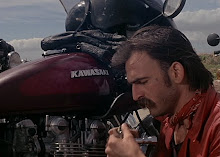I know, I can write about the Morgan Three Wheeler! It's classified as a motorcycle here in the U.S. Hello, loop hole.
The Three Wheeler is a modern nod to the three-wheeled cars of Morgan's past, including the fast versions called the Super Sports. Like all Morgans, they used wood for parts of the chassis and as the name suggests, had three wheels. Two wheels were in the front and one was in the back. Keen observers and those studying for the GMAT will notice that two front wheels plus one back wheel equals three wheels total.
What made the Morgan Super Sports different was not only that it used three wheels, but that it was also powered by a motorcycle engine. The engine was usually a V-twin from Matchless or JAP. Now, since I'm talking about a car, you're expecting the engine to be under a hood (or a bonnet, depending on where you're from) and you'd be wrong.
You see, Morgan mounted the engine outside of the body. Most motorcycle engines of the time were air-cooled, so mounting them in the breeze made perfect sense. Strangely, some Super Sports used liquid-cooled motorcycle engines, so placing them in the breeze ahead of the radiator made less sense. Eventually, the use of motorcycle engines was abandoned and Morgan used a four-cylinder engine mounted inside the body. The three wheels were also soon joined by a fourth wheel and an era came to a close.
Morgan, being a backward-thinking company that still uses wood construction in its 170 mph supercars, decided last year to bring the three wheeler back. The new version is called the Morgan Three Wheeler.
True to form, the tub-like body is there, the front wheels are spoked like the originals and there's an air-cooled motorcycle engine out in the breeze. There are two small screen that act as wind deflectors and two roll hoops behind the seats are for safety...maybe.
Sadly, Matchless and JAP went bust like most of the British motorcycle companies, so the new Three Wheeler is powered by a 1990cc, pushrod S & S V-twin. All 80 of those American horses are funneled to the lone rear wheel through a five-speed manual sourced from the Mazda Miata.
The entire car, er, motorcycle is completely bespoke, so you can choose the color, seat leather and from a whole slew of graphics. Among the graphics are semi-naked ladies, RAF roundels and the 112th Squadron shark mouth. And, yes, part of the chassis is made from wood. Hey, it's light and strong. So what if it's not as sexy as carbon fiber?
All of this elemental motoring is not cheap, however. In the U.S., a Three Wheeler will cost about $40,000.
I don't really care that it's expensive, has an American V-twin and uses wood in the chassis. It looks like a total blast to drive and I really want one. I like that it's completely ridiculous and it knows it. The Three Wheeler does not take itself seriously at all and I find that endearing in so many ways. I'd get one with RAF Roundels, the shark mouth and some stick-on bullet holes.
$40,000 will buy you this or an Acura TL. I think that's an easy decision.


